6.6 Populations and sustainability
1/67
Earn XP
Name | Mastery | Learn | Test | Matching | Spaced |
|---|
No study sessions yet.
68 Terms
what is the carrying capacity?
the maximum number of organisms that can be sustained in a population.
what happens if the population exceeds the carrying capacity?
there will not be enough resources like food, water and space so the number of individuals will decline
what is the limiting factor?
the factor whose magnitude slows down the rate of a natural process
how can a population size change on a graph?
it can:
-remain stable
-rise or fall quite suddenly
-oscillate with a regular pattern
what determines the size of a population?
the balance between death rate (mortality) and the rate of reproduction
what are K-strategists and where are they found?
larger organisms that have longer life-spans and have fewer offspring, as they invest more in each offspring
often found in stable environments
e.g. birds, larger mammals and larger plants
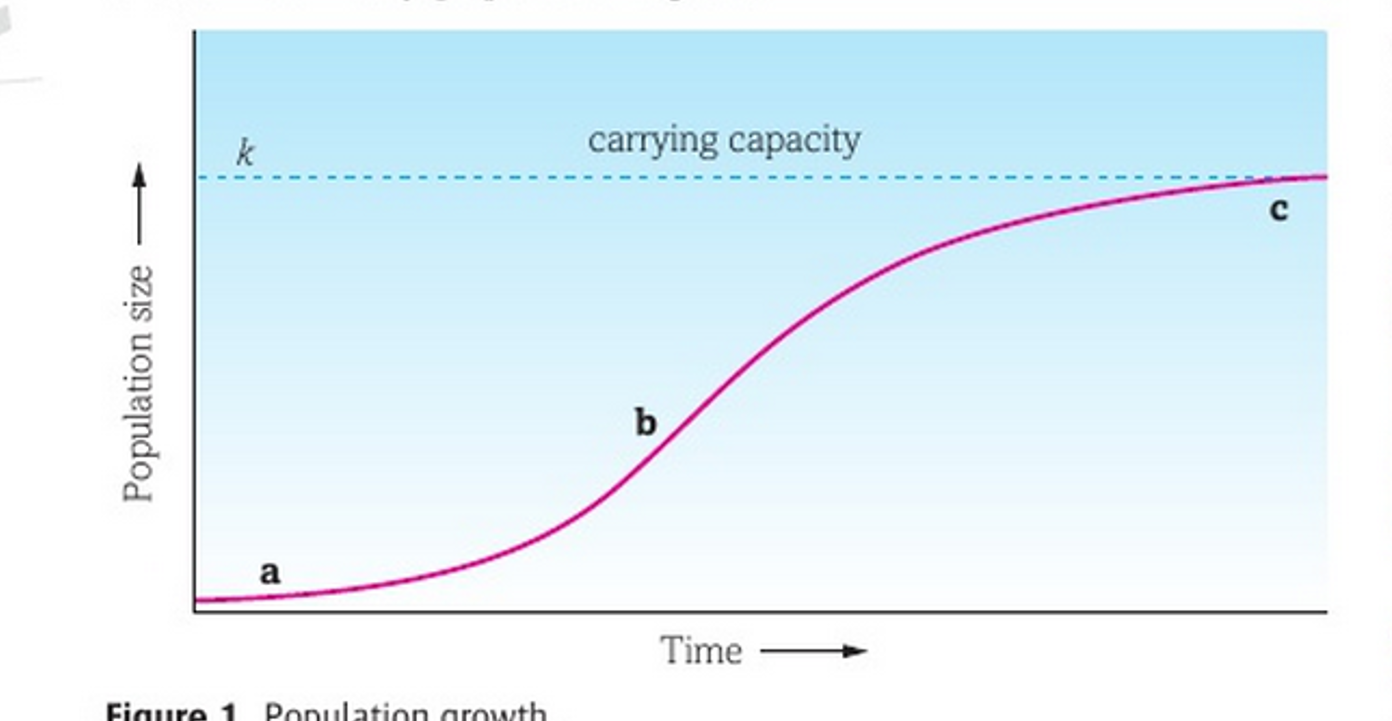
K-strategists: lag phase = A
there may only be a few individuals, they are still acclimatising to their habitat
the rate of reproduction is low, and the growth in population size is slow
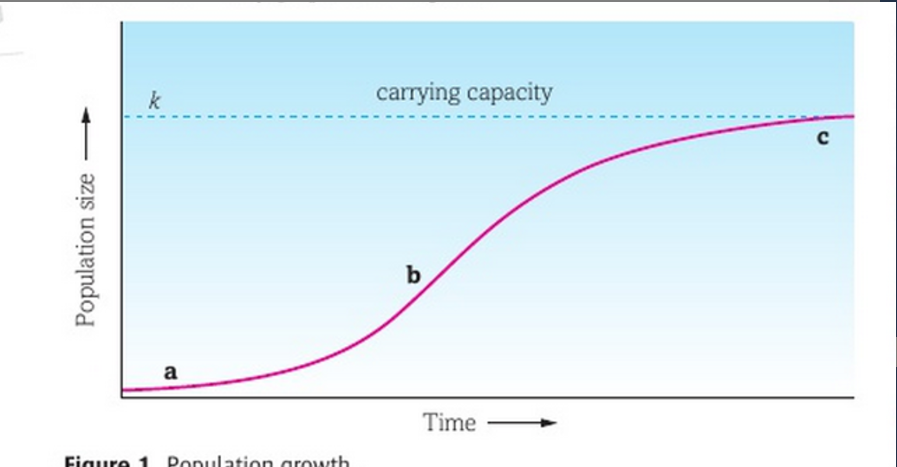
K-strategists: log phase = B
resources are plentiful and conditions are good
reproduction happens quickly exceeding mortality
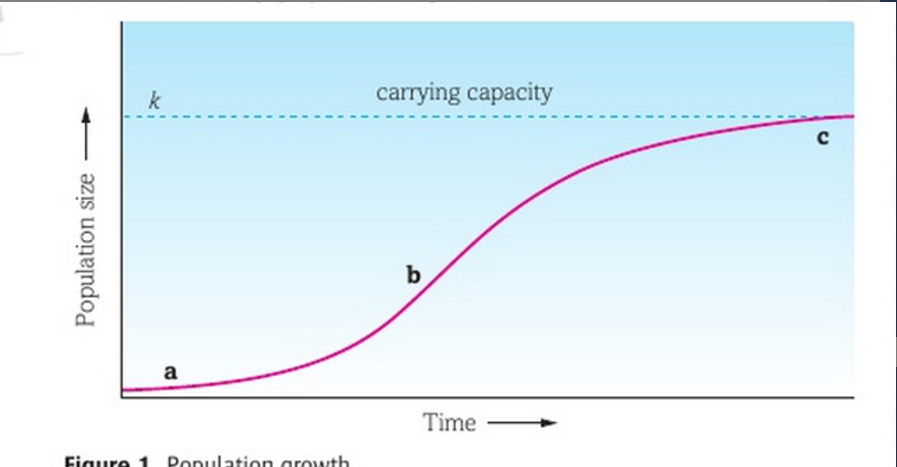
K-strategists: stationary phase = C
the population has levelled out at the carrying capacity of the habitat
the habitat cannot support a larger population
in this phase, the rates of reproduction and mortality are equal
the population remains stable or shows very small fluctuations
what are limiting factors and what is there dependence on size?
the reason a habitat has a carrying capacity is because a factor is limiting further growth
some factors act just as strongly regardless of population size. (density independent) e.g. low temperatures will kill the same proportion of the population irrespective of its size
others are dependent on size (density dependent) and the factor’ influence increases with size
what are K strategists relationship with the carrying capacity?
K-strategist is when the population is determined by carrying capacity
for these populations the limiting factors exert a more and more significant effect as the population size gets closer to the carrying capacity leading to a levelling out
what are K strategists characteristics?
-low reproductive rate
-slow development
-late reproductive age
-long lifespan
-large body mass
what are R-strategists?
species where the population size often increases so quickly that it exceeds the carrying capacity before the limiting factors take effect
then there are no longer enough resources to allow reproduction or survival
the quick build up of waste can also poison the species
this model is often called boom and bust
what are R strategists characteristics?
-high reproductive rate
-quick development
-young reproductive age
-short life span
-small body mass
e.g. mice, insects, weeds and spiders
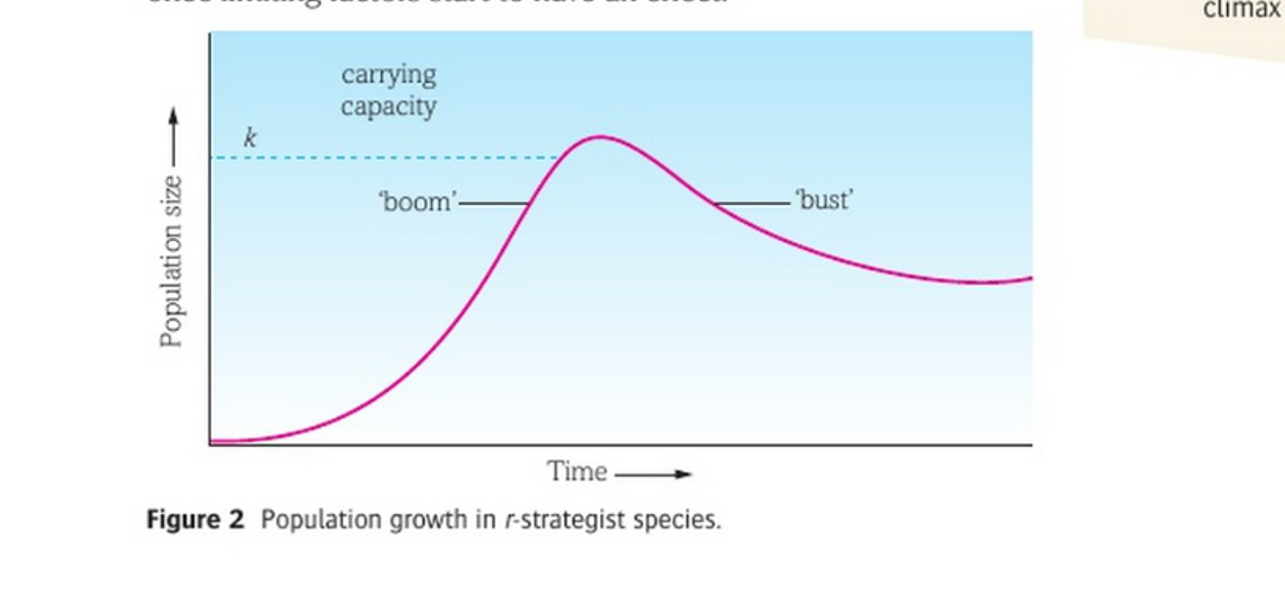
r-strategists population growth
boom- conditions are good and they get over the carrying capacity
bust- resources run out and they die off
what is the most important influence on population growth?
the physical rate at which individuals can reproduce
it is characteristic of species with short generation times and of pioneer species
what is interspecific competition?
competition between individuals of different species
what is intraspecific competition?
competition between individuals of the same species
what is a predator?
an organism that feeds on another living organism (prey) for its food
how does a predator act as a limiting factor on a prey’s population size?
when the predator population gets bigger more prey are eaten
the prey population then gets smaller, so there is less food for the predators
with less food, fewer predators can survive and their population size reduces
with less predators, fewer prey are eaten, and their population size increases
with more prey, the predator population gets bigger and the cycle starts again
when does competition happen?
when resources are in limited supply so organisms have to complete for this resource
as competition intensifies the reproduction rate decreases and death rate increases
why do predators and prey have to evolve together?
if this does not happened they would become extinct
what happens when predators and prey are brought together in a lab?
the prey is usually exterminated
this is due to the unnatural limited range of habitats available
outside of a lab the prey numbers can often drastically drop without becoming extinct
therefore, this must be studied in the wild whenever possible
what happens due to intraspecific competition?
within the species the best suited individuals survive and reproduce, while those not so suited fail to reproduce and/or die
this causes the population to enter a stationary phase
if the population size drops, competition will reduce and the population size can increase again
if the population size increases, more competition occurs leading to a drop
as factors become limiting, individuals compete for food
the individuals best adapted to obtaining food survive and reproduce, while those not so suited fail to reproduce or die
this causes the population growth to slow down and enter a stationary phase
how does intraspecific competition during the stationary phase keep the population size relatively stable?
if the population size drops, competition reduces and the population size increases
if the population size increases, competition increases and the population size drops
what does interspecific competition alter
the distribution of species in an ecosystem
who carried out the case study on interspecific competition and when?
a Russian scientist called Gause in 1934
what did Gause do for the case study for interspecific competition?
he grew two species of Paramecium both separately and together
when together they competed for food. P.aurelia obtained food more effectively than P.caudatum
over 20 days the P. caudatum died out
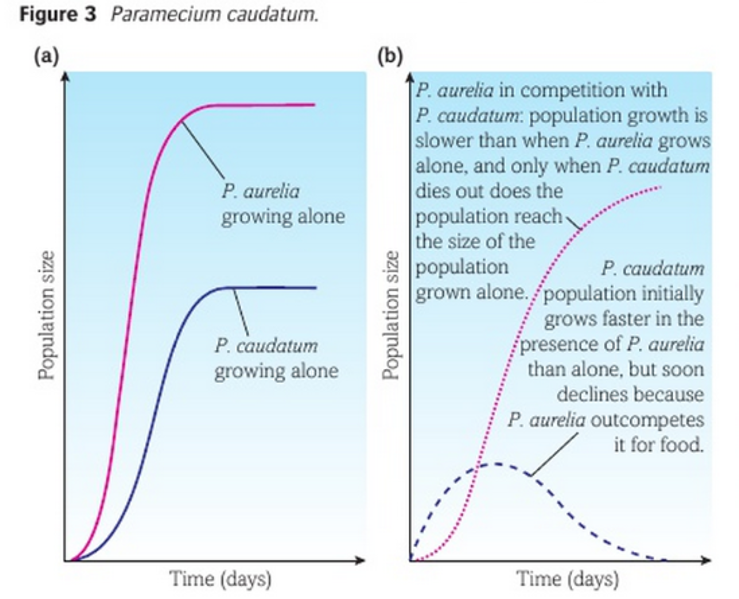
what did Gause find from the case study for interspecific competition?
when together, there was competition for food, with P. aurelia obtaining food more effectively than P. caudatum
over the 20 days, the population of P. caudatum reduced and died out, whereas the population of P. aurelia increased, eventually being the only species remaining
what did Gause conclude from the case study for interspecific competition?
that more overlap between two species’ niches results in more intense competition
what is the competitive exclusion principle?
it explains why particular species only grow in particular places
as if two species have exactly the same niche, one is out-competed by the other and dies out or becomes extinct in that habitat, because two species cannot occupy the same niche
why is the competitive exclusion principle is not always that simple?
other observations and experiments suggest that extinction is not necessarily inevitable
sometimes it simply results in one species simply being much smaller than the other with both populations remaining constant in size
as the environment is constantly changing it is rare for one species to be totally wiped out
how does the laboratory impact observations of interspecific competition?
in the laboratory it is easy to exclude the effects of other variables, so that the habitat remains stable
whereas in the wild a wide range of variables may act as limiting factors for different populations and can change daily or yearly
what experiments initially confirmed the competitive exclusion principle?
experiments on competition between flour beetles Tribolium confusum and T. castaneum
what was found from the flour beetles experiment?
the T. castaneum population size increased, whilst the T. confusum population died out
but even a small change in the temperature could change the outcome, so T. confusum would survive instead
what is conservation?
the maintenance of biodiversity, including diversity between species, genetic diversity within species, and maintenance of a variety of habitats and ecosystems
it is more active than preservation involving human intervention and improving biodiversity
a dynamic process that needs constant adaptation
what is preservation?
the maintenance of habitats and ecosystems in their present condition, minimising human impact and keeping things natural
what are some threats to biodiversity due to a steadily increasing human population?
over-exploitation of wild populations for food, sport or commerce
habitat disruption and fragmentation as a result of intensive agricultural practices, increased pollution or widespread building
what is over-exploitation?
when species are harvested at a faster rate than they can replenish themselves
what is reclamation?
conservation also involves:
managing areas of land
taking steps to encourage new habitats (e.g. controlled burning to clear forests and increase biodiversity)
removing animals to captivity
growing plants in cultivation
reclamation of damaged or destroyed ecosystems
what are ethical/ethological reasons for conservation?
species become extinct as a result of human action
humans have a responsibility to maintain species, ecosystems and habitats for future generations
all organisms have a right to survive and live in the way to which they have become adapted
what are social reasons for conservation?
people enjoy, visiting wild places
observing wildlife- the large animals are sustained by an interdependent web which includes a huge number of species
well-being- physical, intellectual and emotional health
what are economic reasons for conservation?
natural ecosystems provide services and products such as drugs
ecosystems also provide goods such as wood and fish for free
ecotourism
why is there a need for sustainable management?
because of potential conflict between the need for resources and conservation
what are three ways small-scale timber production manage sustainability?
coppicing, pollarding and rotational coppicing
what is coppicing?
the stem of a deciduous tree is cut close to the ground, once cut new shoots grow from the surface and mature into narrow stems
these can be used for fencing, firewood or furniture
after cutting them off, new shoots start to grow again and the cycle continues
what is pollarding?
it involves cutting the stem higher up, to prevent deer eating the emerging shoots
what is rotational coppicing?
it provides a consistent supply of wood, by dividing a wood into sections and cutting one section each year
by the time they want to coppice the first section again the new stems have matured and are ready to be cut
in each section some trees are left to grow larger without being coppiced
these are called standards and are eventually harvested to supply larger pieces of timber
why is rotational coppicing good for biodiversity?
when unmanaged woodland goes through succession and blocks out light from the woodland floor and reduces the number of species growing there
in rotational coppicing different areas of woodland provide different types of habitats
why is large-scale timer production bad for habitats?
it often involves clear felling of all trees in one area which can destroy habitats on a large scale, reduce soil mineral levels and leave soil susceptible to erosion
what is clear felling?
leaving each section of woodland to mature for 50-100 years before felling allows biodiversity to increase
what is a negative of clear felling?
the time scale is not cost effective
what does modern sustainable forestry do?
any tree harvested is replaced by another tree
the forest must maintain its ecological function regarding biodiversity, climate and mineral and water cycles
local people should benefit from the forest
what is selective cutting?
involves removing only the largest, most valuable trees, leaving the habitat broadly unaffected
how can trees be changed to sustainably manage forests?
if each tree supplies more wood, fewer trees ned to be harvested, so foresters
control pests and pathogens
only plant particular tree species where they know they will grow well
position trees an optimal distance apart
what is the Marine Stewardship Council?
fishing has to be done at a level which allows it to continue indefinitely
over-fishing must be avoided
it is ideal to maintain the fish population at the carrying capacity of their environment, so fishing harvests the excess of that capacity
there shouldn’t be permanent damage to the local habitat
what is aquaculture?
raising fish in controlled environments
can provide sustainable fish stocks
restricts the impact on oceanic fish stocks
what is the Terai region?
it is the in south of Nepal
made up of marshy grasslands, savannah and forests
densely populated and home to endangered species